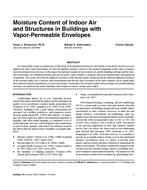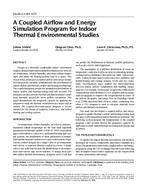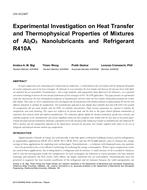Click here to purchase
This paper discusses the development of new, well-insulated, lightweight low-sloped roof constructions [<0.15 W/(m²Ã‚·K) or<0.026 Btu/(h·ft²Ã‚·F)] without conventional vapor barriers but with optimized drying performance. The assemblies consist oftimber I-beams faced with different coverings and insulated with cellulose fibers. Their hygric long-term behavior was optimizedby improving solar-driven moisture transport to the interior by using darker waterproofing layers.In Austria, according to standard OENORM B8110-2 (ASI 2003), avoiding interstitial condensation is evaluated using thedew-point method (Glaser scheme). However, this method as applied in the standard only considers very simplified steady-stateboundary conditions. Neither solar radiation and undercooling nor wetting processes during construction due to driving rainand hygroscopic sorption nor liquid transport are taken into account. Hence, in the current project, a validated model was usedduring the design stage to analyze the interaction between waterproofing and vapor-retarding layers as well as the overall hygrothermalresponse of the roof.Very often, roof constructions are shaded by other buildings, etc., which is why shaded roof constructions were investigatedas well. To verify the simulation results, the assembles were also monitored in a building in Southern Austria.Simulation as well as in situ measurement results are discussed.
Citation: Thermal Performance, International Conference, 2010
Product Details
- Published:
- 2010
- Number of Pages:
- 10
- File Size:
- 1 file , 7.4 MB
- Product Code(s):
- D-BUILDINGSXI-170


